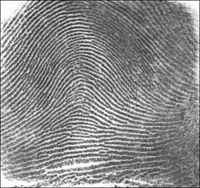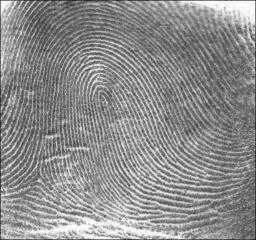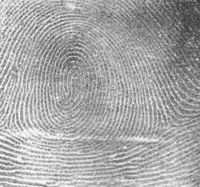Fingerprint recognition
Fingerprint recognition or fingerprint authentication refers to the automated method of verifying a match between two human fingerprints. Fingerprints are one of many forms of biometrics used to identify individuals and verify their identity. This article touches on two major classes of algorithms (minutia and pattern) and four sensor designs (optical, ultrasonic, passive capacitance, and active capacitance).
Background
The analysis of fingerprints for matching purposes generally requires the comparison of several features of the print pattern. These include patterns, which are aggregate characteristics of ridges, and minutia points, which are unique features found within the patterns. It is also necessary to know the structure and properties of human skin in order to successfully employ some of the imaging technologies.
Patterns
The three basic patterns of fingerprint ridges are the arch, loop, and whorl:
- arch: The ridges enter from one side of the finger, rise in the center forming an arc, and then exit the other side of the finger.
- loop: The ridges enter from one side of a finger, form a curve, and then exit on that same side.
- whorl: Ridges form circularly around a central point on the finger.
Scientists have found that family members often share the same general fingerprint patterns, leading to the belief that these patterns are inherited.
 The arch pattern. |
 The loop pattern. |
 The whorl pattern. |
Minutia features
The major Minutia features of fingerprint ridges are: ridge ending, bifurcation, and short ridge (or dot). The ridge ending is the point at which a ridge terminates. Bifurcations are points at which a single ridge splits into two ridges. Short ridges (or dots) are ridges which are significantly shorter than the average ridge length on the fingerprint. Minutiae and patterns are very important in the analysis of fingerprints since no two fingers have been shown to be identical.
 Ridge ending. |
 Bifurcation. |
 Short Ridge (Dot). |
Fingerprint sensors
A fingerprint sensor is an electronic device used to capture a digital image of the fingerprint pattern. The captured image is called a live scan. This live scan is digitally processed to create a biometric template (a collection of extracted features) which is stored and used for matching. This is an overview of some of the more commonly used fingerprint sensor technologies.
Optical
Optical fingerprint imaging involves capturing a digital image of the print using visible light. This type of sensor is, in essence, a specialized digital camera. The top layer of the sensor, where the finger is placed, is known as the touch surface. Beneath this layer is a light-emitting phosphor layer which illuminates the surface of the finger. The light reflected from the finger passes through the phosphor layer to an array of solid state pixels (a charge-coupled device) which captures a visual image of the fingerprint. A scratched or dirty touch surface can cause a bad image of the fingerprint. A disadvantage of this type of sensor is the fact that the imaging capabilities are affected by the quality of skin on the finger. For instance, a dirty or marked finger is difficult to image properly. Also, it is possible for an individual to erode the outer layer of skin on the fingertips to the point where the fingerprint is no longer visible. It can also be easily fooled by an image of a fingerprint if not coupled with a "live finger" detector. However, unlike capacitive sensors, this sensor technology is not susceptible to electrostatic discharge damage.
Fingerprints can be read from a distance.[1]
Ultrasonic
Ultrasonic sensors make use of the principles of medical ultrasonography in order to create visual images of the fingerprint. Unlike optical imaging, ultrasonic sensors use very high frequency sound waves to penetrate the epidermal layer of skin. The sound waves are generated using piezoelectric transducers and reflected energy is also measured using piezoelectric materials. Since the dermal skin layer exhibits the same characteristic pattern of the fingerprint, the reflected wave measurements can be used to form an image of the fingerprint. This eliminates the need for clean, undamaged epidermal skin and a clean sensing surface.
Capacitance
Capacitance sensors use principles associated with capacitance in order to form fingerprint images. In this method of imaging, the sensor array pixels each act as one plate of a parallel-plate capacitor, the dermal layer (which is electrically conductive) acts as the other plate, and the non-conductive epidermal layer acts as a dielectric.
Passive capacitance
A passive capacitance sensor use the principle outlined above to form an image of the fingerprint patterns on the dermal layer of skin. Each sensor pixel is used to measure the capacitance at that point of the array. The capacitance varies between the ridges and valleys of the fingerprint due to the fact that the volume between the dermal layer and sensing element in valleys contains an air gap. The dielectric constant of the epidermis and the area of the sensing element are known values. The measured capacitance values are then used to distinguish between fingerprint ridges and valleys.
Active capacitance
Active capacitance sensors use a charging cycle to apply a voltage to the skin before measurement takes place. The application of voltage charges the effective capacitor. The electric field between the finger and sensor follows the pattern of the ridges in the dermal skin layer. On the discharge cycle, the voltage across the dermal layer and sensing element is compared against a reference voltage in order to calculate the capacitance. The distance values are then calculated mathematically, and used to form an image of the fingerprint. Active capacitance sensors measure the ridge patterns of the dermal layer like the ultrasonic method. Again, this eliminates the need for clean, undamaged epidermal skin and a clean sensing surface.[7]
Algorithms
Matching algorithms are used to compare previously stored templates of fingerprints against candidate fingerprints for authentication purposes. In order to do this either the original image must be directly compared with the candidate image or certain features must be compared.
Pattern-based (or image-based) algorithms
Pattern based algorithms compare the basic fingerprint patterns (arch, whorl, and loop) between a previously stored template and a candidate fingerprint. This requires that the images be aligned in the same orientation. To do this, the algorithm finds a central point in the fingerprint image and centers on that. In a pattern-based algorithm, the template contains the type, size, and orientation of patterns within the aligned fingerprint image. The candidate fingerprint image is graphically compared with the template to determine the degree to which they match.
See also
- Fingerprint Verification Competition
- Online Fingerprint Identification SDK, Saurabh
- Biometrics
- Authentication
- Fingerprint
- Minutiae
- Feature extraction
- Skin
- Heredity
- Medical ultrasonography
- Piezoelectricity
- Biometric technology in access control
- Finger Vein recognition
- Iris recognition
References
- ^ Jain, L.C. et al. (Eds.). 1999. Intelligent Biometric Techniques in Fingerprint and Face Recognition. Boca Raton, FL: CRC Press.
- ^ Langenburg, Glenn (January 24, 2005). "Are one's fingerprints similar to those of his or her parents in any discernable way?". Scientific American. Retrieved 28 August 2010.
- ^ Thornton, John (May 9, 2000). "Latent Fingerprints, Setting Standards In The Comparison and Identification". 84th Annual Training Conference of the California State Division of IAI. Retrieved 30 August 2010.
- ^ Diaz, Raul (2007). "Biometrics: Security Vs Convenience". SecurityWorld Magazine. Retrieved 30 August 2010.
- ^ "Validity and Acceptability of Results in Fingerprint Scanners".
- ^ Setlak, Dale. "Advances in Biometric Fingerprint Technology are Driving Rapid Adoption in Consumer Marketplace". AuthenTec. Retrieved 4 November 2010.
- ^ a US patent 7597250, issued 2009-10-06
- ^ Mazumdar, Subhra; Dhulipala, Venkata (2008). "Biometric Security Using Finger Print Recognition" (PDF). University of California, San Diego. p. 3. Retrieved 30 August 2010.
- ^ Minutia vs. Pattern Based Fingerprint Templates. (2003). Retrieved December 13, 2005, from http://web.archive.org/web/20070929083052/http://www.ibia.org/membersadmin/whitepapers/pdf/9/M_vs_P_White+Paper_v2.pdf (archived from www.ibia.org on 2007-09-29)